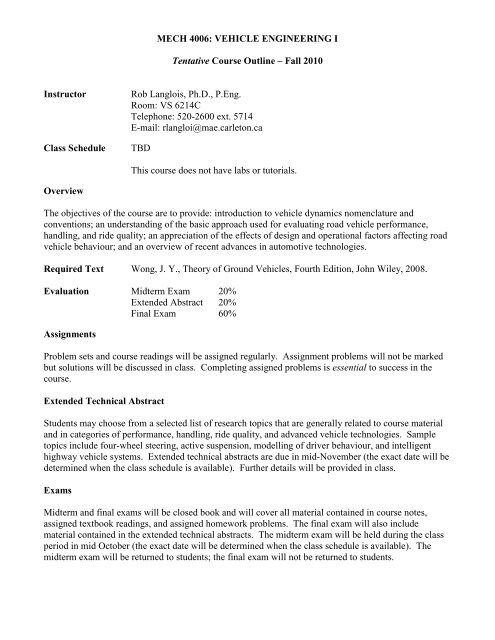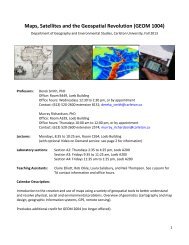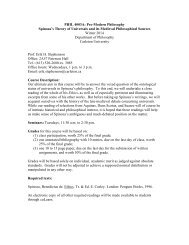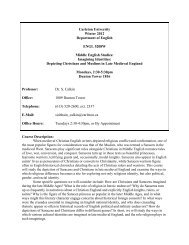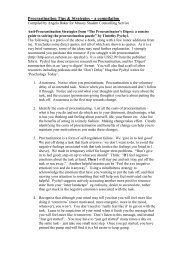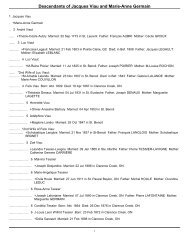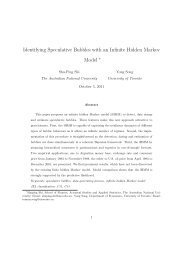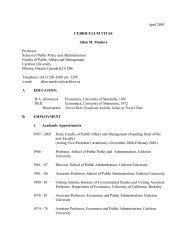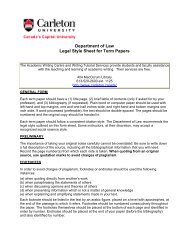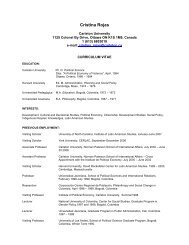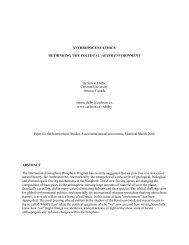MECH 4006: VEHICLE ENGINEERING I Tentative Course Outline ...
MECH 4006: VEHICLE ENGINEERING I Tentative Course Outline ...
MECH 4006: VEHICLE ENGINEERING I Tentative Course Outline ...
You also want an ePaper? Increase the reach of your titles
YUMPU automatically turns print PDFs into web optimized ePapers that Google loves.
<strong>MECH</strong> <strong>4006</strong>: <strong>VEHICLE</strong> <strong>ENGINEERING</strong> I<strong>Tentative</strong> <strong>Course</strong> <strong>Outline</strong> – Fall 2010InstructorClass ScheduleRob Langlois, Ph.D., P.Eng.Room: VS 6214CTelephone: 520-2600 ext. 5714E-mail: rlangloi@mae.carleton.caTBDThis course does not have labs or tutorials.OverviewThe objectives of the course are to provide: introduction to vehicle dynamics nomenclature andconventions; an understanding of the basic approach used for evaluating road vehicle performance,handling, and ride quality; an appreciation of the effects of design and operational factors affecting roadvehicle behaviour; and an overview of recent advances in automotive technologies.Required Text Wong, J. Y., Theory of Ground Vehicles, Fourth Edition, John Wiley, 2008.Evaluation Midterm Exam 20%Extended Abstract 20%Final Exam 60%AssignmentsProblem sets and course readings will be assigned regularly. Assignment problems will not be markedbut solutions will be discussed in class. Completing assigned problems is essential to success in thecourse.Extended Technical AbstractStudents may choose from a selected list of research topics that are generally related to course materialand in categories of performance, handling, ride quality, and advanced vehicle technologies. Sampletopics include four-wheel steering, active suspension, modelling of driver behaviour, and intelligenthighway vehicle systems. Extended technical abstracts are due in mid-November (the exact date will bedetermined when the class schedule is available). Further details will be provided in class.ExamsMidterm and final exams will be closed book and will cover all material contained in course notes,assigned textbook readings, and assigned homework problems. The final exam will also includematerial contained in the extended technical abstracts. The midterm exam will be held during the classperiod in mid October (the exact date will be determined when the class schedule is available). Themidterm exam will be returned to students; the final exam will not be returned to students.
Academic AccommodationYou may need special arrangements to meet your academic obligations during the term because ofdisability, pregnancy or religious obligations. Please review the course outline promptly and write to mewith any requests for academic accommodation during the first two weeks of class, or as soon aspossible after the need for accommodation is known to exist.Students with disabilities requiring academic accommodations in this course must register with the PaulMenton Centre for Students with Disabilities (PMC) for a formal evaluation of disability-related needs.Documented disabilities could include but not limited to mobility/physical impairments, specificLearning Disabilities (LD), psychiatric/psychological disabilities, sensory disabilities, Attention DeficitHyperactivity Disorder (ADHD), and chronic medical conditions. Registered PMC students are requiredto contact the PMC, 613-520-6608, every term to ensure that your Instructor receives your Letter ofAccommodation, no later than two weeks before the first assignment is due or the first in-classtest/midterm requiring accommodations. If you only require accommodations for your formallyscheduled exam(s) in this course, please submit your request for accommodations to PMC by the lastofficial day to withdraw from classes in each term.<strong>Outline</strong>Week Topics1,2 Performance characteristics of ground vehicles. Motion of a vehicle as a rigid body. Propertiesof pneumatic tires: rolling resistance, tractive (braking) effort and longitudinal slip (skid),performance on wet surfaces.3 Aerodynamic drag estimation. Dynamic load transfer, maximum transferable tractive force.4 Acceleration limits, gradability, deceleration and braking, maximum deceleration rates, stoppingdistance. Antilock braking systems.5,6 Power plant performance and selection. Transmission characteristics, selection of gear ratios.Vehicle performance analysis, estimation of acceleration time and distance.7 Handling characteristics of road vehicles. Lateral behaviour of pneumatic tires, lateral force andside slip angle, cornering stiffness.8,9 Steady state cornering. Neutral steer, understeer, and oversteer. Directional stability of roadvehicles. Characteristic speed and critical speed. Steady state response characteristics. Activestability control. Four-wheel steering.10 Transient handling characteristics. Testing of handling performance.11 Ride characteristics of ground vehicles. General vehicle ride models, linear model of sprung andunsprung mass. Two-degrees-of-freedom ride model for sprung mass, pitch and bounce,oscillation centres.12 Criteria for good ride, dynamic index, flat riding tuning. Suspension mechanics. Suspensiondynamic properties. Active and semi-active suspensions.13 Review


